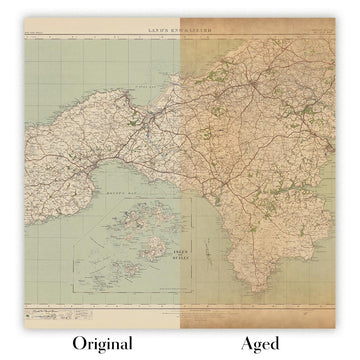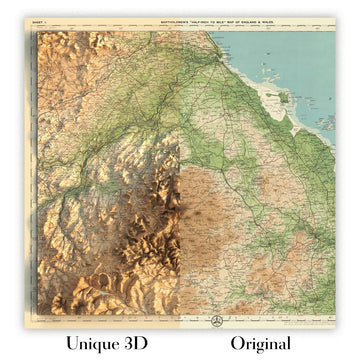

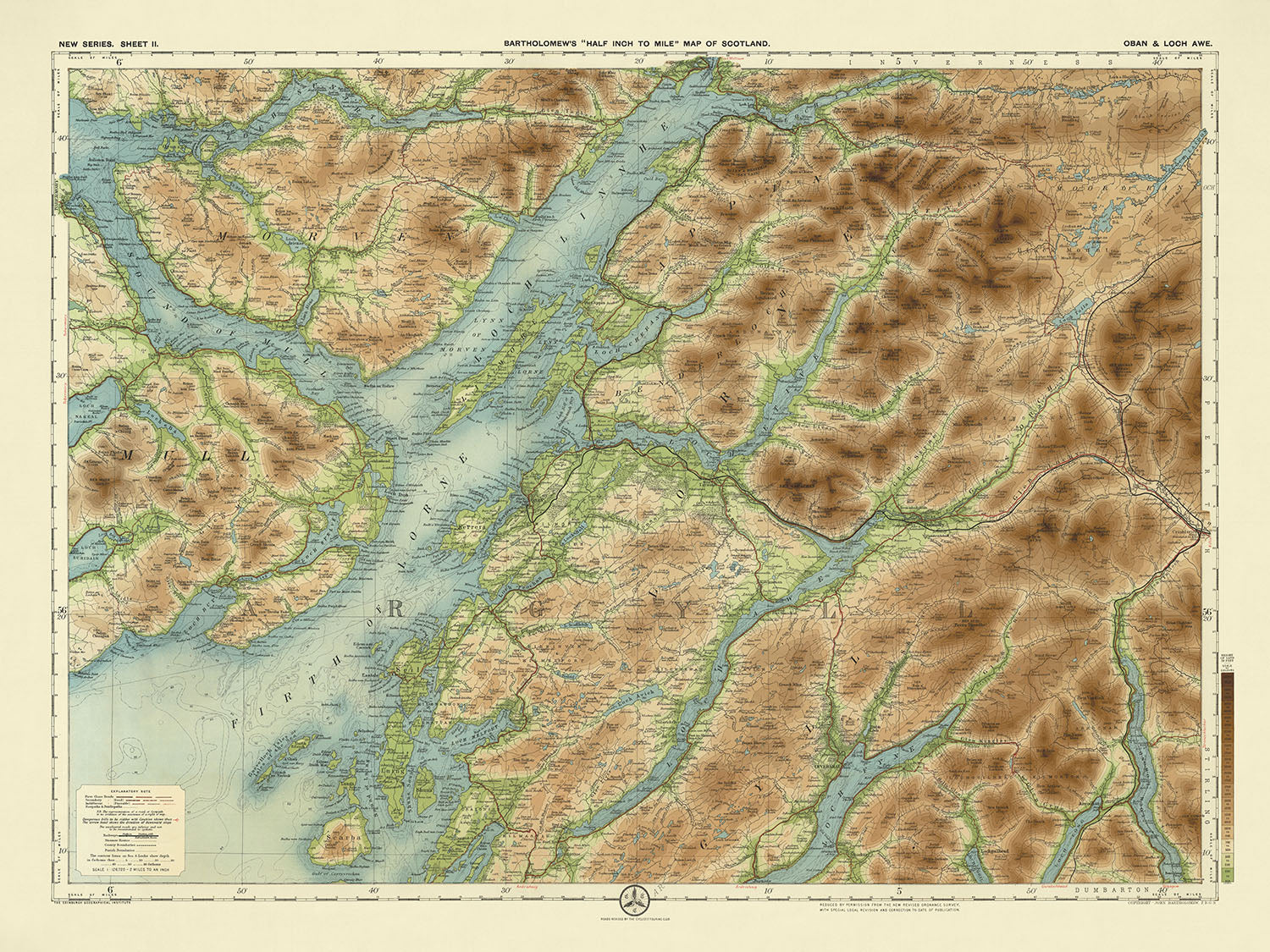

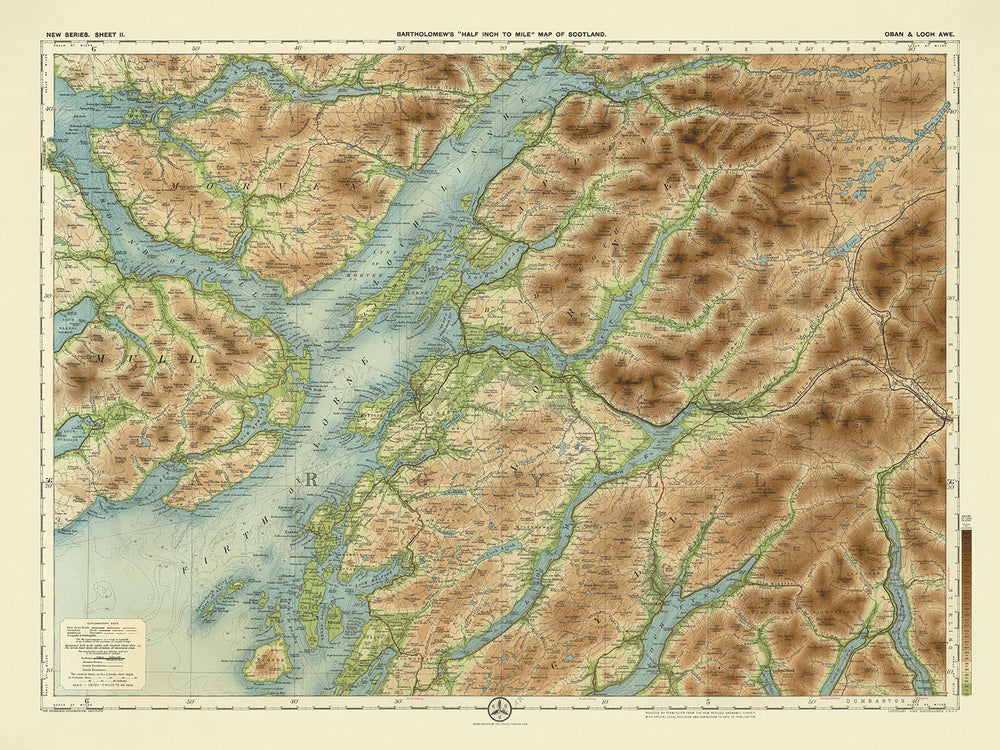

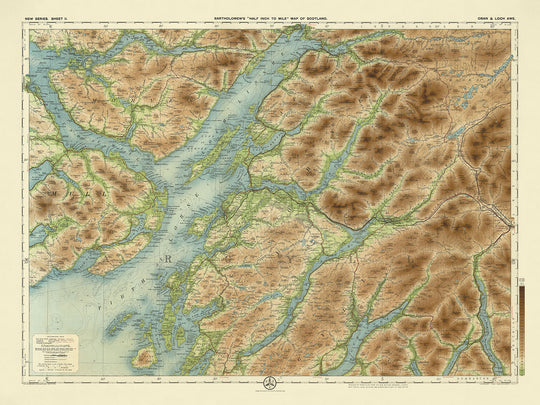







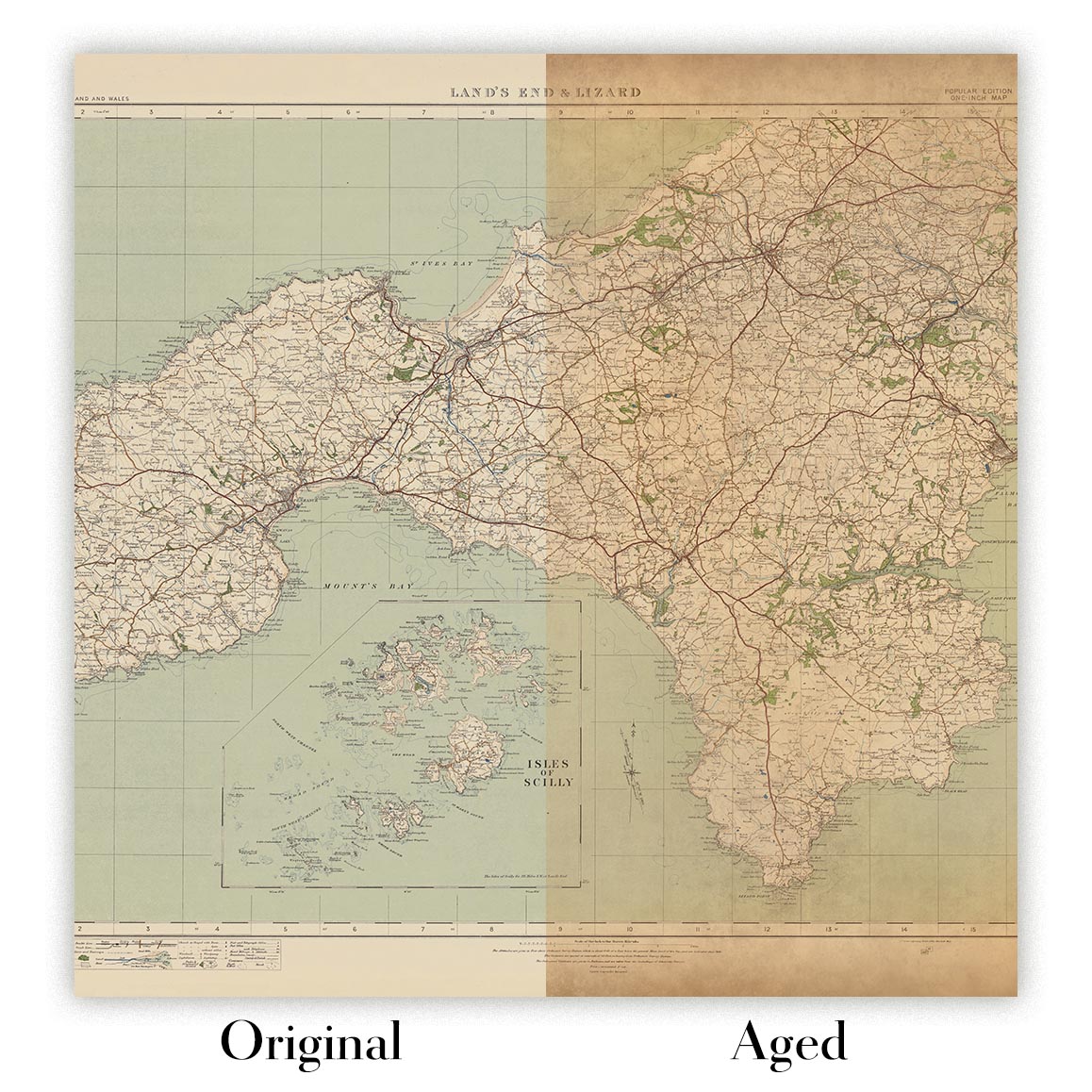



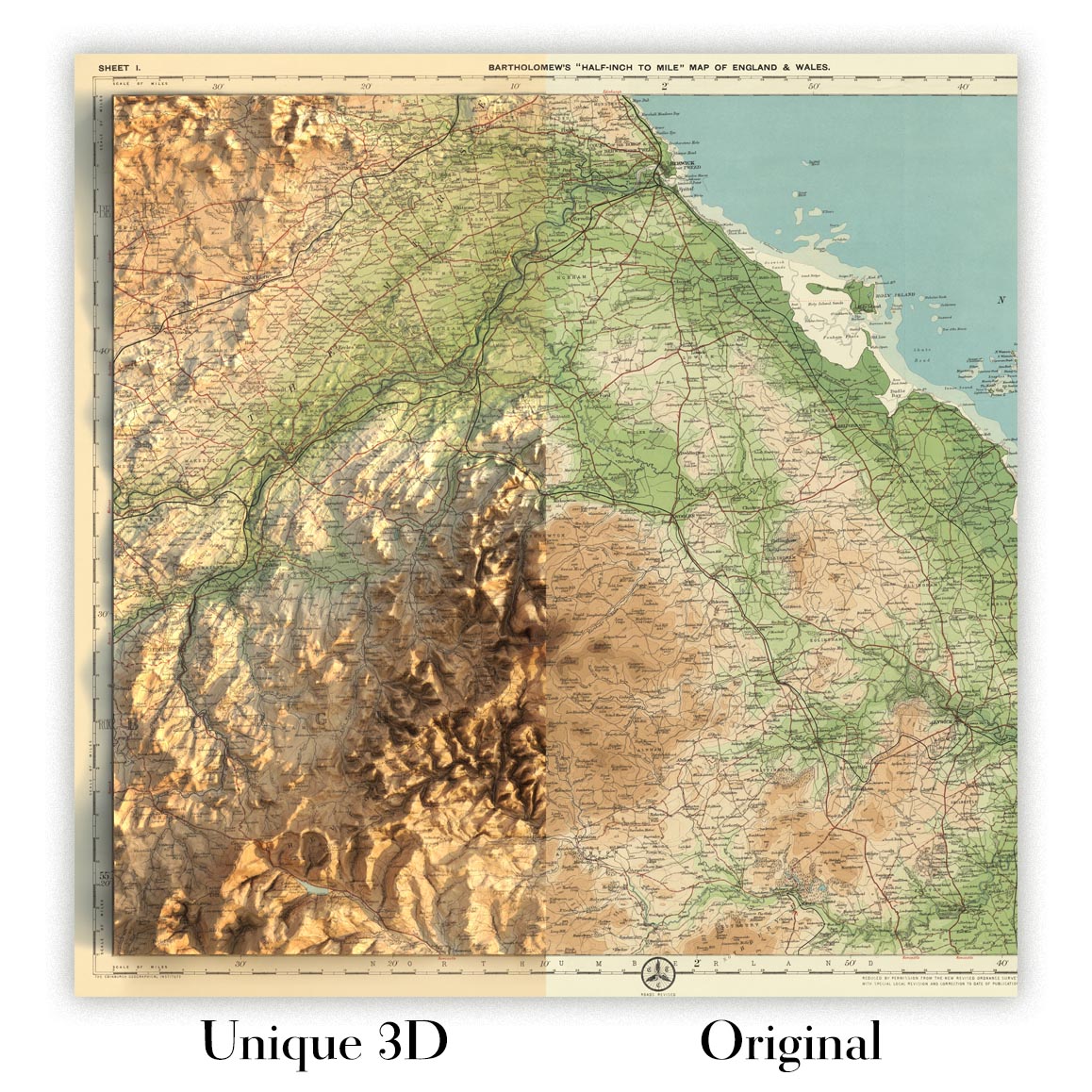



Old OS Map of Oban & Loch Awe, Argyllshire by Bartholomew, 1901: Firth of Lorn, Loch Awe, Ben Cruachan, Glen Coe, Isle of Mull, Loch Lomond


-
![]() Handmade in Australia
Handmade in Australia
-
FREE worldwide delivery in 2-3 days ⓘ
Free delivery in 2-3 days
Your map should be delivered in 2-3 working days with free delivery, worldwide.
We make maps by hand locally in 23 countries, including Australia
![]() . If you're buying a gift for someone in another country, we will make the map locally to them.
. If you're buying a gift for someone in another country, we will make the map locally to them.You will never pay import tax or customs duty.
Express delivery is available at checkout which can reduce the delivery time to 1-2 days.
Please note that personalised maps, and larger framed maps, can take longer to produce and deliver.
If you need your order to arrive by a certain date, contact me and we can discuss your options.
-
90 day money back guarantee
ⓘ
90 days to return and refund
Products can be returned within 90 days for a full refund, or exchange for another product.
For personalised and custom made items, we may offer you store credit or a non-expiring gift card, as we cannot resell personalised orders.
If you have any questions, get in touch. For more information, see our full returns & exchanges policy.

My maps are rare, museum-grade, restored old maps sourced from libraries, auction houses and private collections across the globe.
Framing & free personalisation available
1. Select your size
➢ Pick the closest size (above)
➢ Provide the exact size in millimetres
➢ Add to bag and checkout as normal
2. Frame & personalise your map
Make your map unique with framing, hand-drawn customisation, vintage ageing, pop art text, unique 3D styling and moreGift message & custom finish

If you want to add a gift message, or a finish (jigsaw, aluminium board, etc.) that is not available here, please request it in the "order note" when you check out.
Every order is custom made, so if you need the size adjusted slightly, or printed on an unusual material, just let us know. We've done thousands of custom orders over the years, so there's (almost) nothing we can't manage.
You can also contact us before you order, if you prefer!

- Handmade locally. No import duty or tax
- FREE Delivery. Arrives in 2-3 days
- Love it or your money back
- Questions? WhatsApp me any time
Own a piece of history
5,000+ 5 star reviews


Sheet 11 - Oban & Loch Awe, crafted by the esteemed JG Bartholomew in 1901, is a captivating glimpse into the western Highlands of Scotland at the turn of the 20th century. This map, part of Bartholomew's renowned Half-Inch to the Mile series, was a favourite among cyclists and tourists, celebrated for its clarity and vibrant use of colour. Bartholomew's innovative technique of using gradations of colour to depict landscape relief adds a unique visual appeal, making the map both a functional navigational tool and a work of art. The map's meticulous detail and aesthetic beauty reflect Bartholomew's reputation as one of Scotland's foremost cartographers.
The design of this map is particularly striking, employing a landscape orientation that spans 36 miles from north to south and 52 miles from west to east. The careful gradation of colours not only highlights the varied topography but also brings the region's natural beauty to life. From the serene waters of Loch Awe and Loch Etive to the rugged peaks of Ben Cruachan and Ben More, the map captures the dramatic contrasts of the Scottish landscape. The intricate depiction of glens such as Glen Coe and Glen Orchy further enhances the map's allure, offering a detailed view of the region's valleys and waterways.
Historically, this map provides invaluable insight into the geography and infrastructure of the area during a period of burgeoning tourism and transportation development. The inclusion of roads, railways, and other transportation routes underscores the growing accessibility of the Highlands, making it a significant document for understanding the era's travel and exploration trends. The map also reflects the cultural and economic importance of towns like Oban, Lochgilphead, and Inveraray, which served as key hubs for trade and tourism.
The natural features highlighted on this map are as diverse as they are breathtaking. Loch Lomond, Loch Tay, and Loch Fyne are just a few of the prominent bodies of water that dominate the landscape, each with its own unique charm and historical significance. The Sound of Mull and the Firth of Lorn further illustrate the region's intricate network of waterways, which have long been vital for transportation and commerce. The inclusion of the Isle of Mull, Isle of Jura, Isle of Islay, and Isle of Bute adds another layer of geographic interest, showcasing the archipelago's rich and varied terrain.
Bartholomew's map is not just a representation of physical geography but also a window into the historical and cultural context of the time. The detailed portrayal of natural phenomena, such as the dramatic mountain ranges and serene lochs, invites viewers to explore the Highlands' majestic landscapes. This map stands as a testament to Bartholomew's cartographic prowess and his ability to blend scientific precision with artistic elegance, making it a treasured piece for collectors and history enthusiasts alike.
Cities and towns on this map
- Argyllshire:
- Oban (modern-day population: ~8,500)
- Lochgilphead (modern-day population: ~2,300)
- Inveraray (modern-day population: ~600)
- Perthshire:
- Killin (modern-day population: ~700)
Notable Features & Landmarks
- Loch Awe
- Loch Etive
- Loch Fyne
- Loch Lomond
- Loch Tay
- Loch Eck
- Ben Cruachan
- Ben Lui
- Ben More
- Glen Coe
- Glen Orchy
- Glen Lochy
- Glen Etive
- Glen Strae
- Sound of Mull
- Firth of Lorn
- Isle of Mull
- Isle of Jura
- Isle of Islay
- Isle of Bute
Historical and design context
- A clear, attractive and colourful map at the half-inch to the mile scale (1:126,720).
- Popular with cyclists and tourists, and became Bartholomew's flagship series.
- Used different layers of colour to represent landscape relief, with a subtle and innovative gradation of colour bands to show land at different heights.
- Based on a reduced Ordnance Survey map from the same period.
- Date of creation: 1901
- Mapmaker/Publisher: JG Bartholomew
- Bartholomew was a renowned Scottish cartographer known for his detailed and aesthetically pleasing maps.
- The map highlights the natural beauty and geographical diversity of the region, making it useful for both practical navigation and educational purposes.
- The use of colour gradation to indicate elevation was innovative for its time and added a visual appeal that made the map both functional and artistic.
- The map is a valuable historical document that provides insight into the geography and infrastructure of the region at the turn of the 20th century.
- Reflects the growing popularity of cycling and tourism during this period, as well as advancements in cartographic techniques.
Please double check the images to make sure that a specific town or place is shown on this map. You can also get in touch and ask us to check the map for you.
This map looks great at every size, but I always recommend going for a larger size if you have space. That way you can easily make out all of the details.
This map looks amazing at sizes all the way up to 70in (180cm). If you are looking for a larger map, please get in touch.
Please note: the labels on this map are hard to read if you order a map that is 20in (50cm) or smaller. The map is still very attractive, but if you would like to read the map easily, please buy a larger size.
The model in the listing images is holding the 18x24in (45x60cm) version of this map.
The fifth listing image shows an example of my map personalisation service.
If you’re looking for something slightly different, check out my collection of the best old maps to see if something else catches your eye.
Please contact me to check if a certain location, landmark or feature is shown on this map.
This would make a wonderful birthday, Christmas, Father's Day, work leaving, anniversary or housewarming gift for someone from the areas covered by this map.
This map is available as a giclée print on acid free archival matte paper, or you can buy it framed. The frame is a nice, simple black frame that suits most aesthetics. Please get in touch if you'd like a different frame colour or material. My frames are glazed with super-clear museum-grade acrylic (perspex/acrylite), which is significantly less reflective than glass, safer, and will always arrive in perfect condition.
This map is also available as a float framed canvas, sometimes known as a shadow gap framed canvas or canvas floater. The map is printed on artist's cotton canvas and then stretched over a handmade box frame. We then "float" the canvas inside a wooden frame, which is available in a range of colours (black, dark brown, oak, antique gold and white). This is a wonderful way to present a map without glazing in front. See some examples of float framed canvas maps and explore the differences between my different finishes.
For something truly unique, this map is also available in "Unique 3D", our trademarked process that dramatically transforms the map so that it has a wonderful sense of depth. We combine the original map with detailed topography and elevation data, so that mountains and the terrain really "pop". For more info and examples of 3D maps, check my Unique 3D page.
For most orders, delivery time is about 3 working days. Personalised and customised products take longer, as I have to do the personalisation and send it to you for approval, which usually takes 1 or 2 days.
Please note that very large framed orders usually take longer to make and deliver.
If you need your order to arrive by a certain date, please contact me before you order so that we can find the best way of making sure you get your order in time.
I print and frame maps and artwork in 23 countries around the world. This means your order will be made locally, which cuts down on delivery time and ensures that it won't be damaged during delivery. You'll never pay customs or import duty, and we'll put less CO2 into the air.
All of my maps and art prints are well packaged and sent in a rugged tube if unframed, or surrounded by foam if framed.
I try to send out all orders within 1 or 2 days of receiving your order, though some products (like face masks, mugs and tote bags) can take longer to make.
If you select Express Delivery at checkout your order we will prioritise your order and send it out by 1-day courier (Fedex, DHL, UPS, Parcelforce).
Next Day delivery is also available in some countries (US, UK, Singapore, UAE) but please try to order early in the day so that we can get it sent out on time.
My standard frame is a gallery style black ash hardwood frame. It is simple and quite modern looking. My standard frame is around 20mm (0.8in) wide.
I use super-clear acrylic (perspex/acrylite) for the frame glass. It's lighter and safer than glass - and it looks better, as the reflectivity is lower.
Six standard frame colours are available for free (black, dark brown, dark grey, oak, white and antique gold). Custom framing and mounting/matting is available if you're looking for something else.
Most maps, art and illustrations are also available as a framed canvas. We use matte (not shiny) cotton canvas, stretch it over a sustainably sourced box wood frame, and then 'float' the piece within a wood frame. The end result is quite beautiful, and there's no glazing to get in the way.
All frames are provided "ready to hang", with either a string or brackets on the back. Very large frames will have heavy duty hanging plates and/or a mounting baton. If you have any questions, please get in touch.
See some examples of my framed maps and framed canvas maps.
Alternatively, I can also supply old maps and artwork on canvas, foam board, cotton rag and other materials.
If you want to frame your map or artwork yourself, please read my size guide first.
My maps are extremely high quality reproductions of original maps.
I source original, rare maps from libraries, auction houses and private collections around the world, restore them at my London workshop, and then use specialist giclée inks and printers to create beautiful maps that look even better than the original.
My maps are printed on acid-free archival matte (not glossy) paper that feels very high quality and almost like card. In technical terms the paper weight/thickness is 10mil/200gsm. It's perfect for framing.
I print with Epson ultrachrome giclée UV fade resistant pigment inks - some of the best inks you can find.
I can also make maps on canvas, cotton rag and other exotic materials.
Learn more about The Unique Maps Co.
Map personalisation
If you're looking for the perfect anniversary or housewarming gift, I can personalise your map to make it truly unique. For example, I can add a short message, or highlight an important location, or add your family's coat of arms.
The options are almost infinite. Please see my map personalisation page for some wonderful examples of what's possible.
To order a personalised map, select "personalise your map" before adding it to your basket.
Get in touch if you're looking for more complex customisations and personalisations.
Map ageing
I have been asked hundreds of times over the years by customers if they could buy a map that looks even older.
Well, now you can, by selecting Aged before you add a map to your basket.
All the product photos you see on this page show the map in its Original form. This is what the map looks like today.
If you select Aged, I will age your map by hand, using a special and unique process developed through years of studying old maps, talking to researchers to understand the chemistry of aging paper, and of course... lots of practice!
If you're unsure, stick to the Original colour of the map. If you want something a bit darker and older looking, go for Aged.
If you are not happy with your order for any reason, contact me and I'll get it fixed ASAP, free of charge. Please see my returns and refund policy for more information.
I am very confident you will like your restored map or art print. I have been doing this since 1984. I'm a 5-star Etsy seller. I have sold tens of thousands of maps and art prints and have over 5,000 real 5-star reviews. My work has been featured in interior design magazines, on the BBC, and on the walls of dozens of 5-star hotels.
I use a unique process to restore maps and artwork that is massively time consuming and labour intensive. Hunting down the original maps and illustrations can take months. I use state of the art and eye-wateringly expensive technology to scan and restore them. As a result, I guarantee my maps and art prints are a cut above the rest. I stand by my products and will always make sure you're 100% happy with what you receive.
Almost all of my maps and art prints look amazing at large sizes (200cm, 6.5ft+) and I can frame and deliver them to you as well, via special oversized courier. Contact me to discuss your specific needs.
Or try searching for something!
This service is currently unavailable,
sorry for the inconvenience.
Pair it with a frame
Frame options are for visualization purposes only.
FRAME STYLE
MATTING SIZE
BUILDING YOUR EXPERIENCE
powered by Blankwall
Take a few steps back and let your camera see more of the scene.
powered by Blankwall
Was this experience helpful?
Sheet 11 - Oban & Loch Awe, crafted by the esteemed JG Bartholomew in 1901, is a captivating glimpse into the western Highlands of Scotland at the turn of the 20th century. This map, part of Bartholomew's renowned Half-Inch to the Mile series, was a favourite among cyclists and tourists, celebrated for its clarity and vibrant use of colour. Bartholomew's innovative technique of using gradations of colour to depict landscape relief adds a unique visual appeal, making the map both a functional navigational tool and a work of art. The map's meticulous detail and aesthetic beauty reflect Bartholomew's reputation as one of Scotland's foremost cartographers.
The design of this map is particularly striking, employing a landscape orientation that spans 36 miles from north to south and 52 miles from west to east. The careful gradation of colours not only highlights the varied topography but also brings the region's natural beauty to life. From the serene waters of Loch Awe and Loch Etive to the rugged peaks of Ben Cruachan and Ben More, the map captures the dramatic contrasts of the Scottish landscape. The intricate depiction of glens such as Glen Coe and Glen Orchy further enhances the map's allure, offering a detailed view of the region's valleys and waterways.
Historically, this map provides invaluable insight into the geography and infrastructure of the area during a period of burgeoning tourism and transportation development. The inclusion of roads, railways, and other transportation routes underscores the growing accessibility of the Highlands, making it a significant document for understanding the era's travel and exploration trends. The map also reflects the cultural and economic importance of towns like Oban, Lochgilphead, and Inveraray, which served as key hubs for trade and tourism.
The natural features highlighted on this map are as diverse as they are breathtaking. Loch Lomond, Loch Tay, and Loch Fyne are just a few of the prominent bodies of water that dominate the landscape, each with its own unique charm and historical significance. The Sound of Mull and the Firth of Lorn further illustrate the region's intricate network of waterways, which have long been vital for transportation and commerce. The inclusion of the Isle of Mull, Isle of Jura, Isle of Islay, and Isle of Bute adds another layer of geographic interest, showcasing the archipelago's rich and varied terrain.
Bartholomew's map is not just a representation of physical geography but also a window into the historical and cultural context of the time. The detailed portrayal of natural phenomena, such as the dramatic mountain ranges and serene lochs, invites viewers to explore the Highlands' majestic landscapes. This map stands as a testament to Bartholomew's cartographic prowess and his ability to blend scientific precision with artistic elegance, making it a treasured piece for collectors and history enthusiasts alike.
Cities and towns on this map
- Argyllshire:
- Oban (modern-day population: ~8,500)
- Lochgilphead (modern-day population: ~2,300)
- Inveraray (modern-day population: ~600)
- Perthshire:
- Killin (modern-day population: ~700)
Notable Features & Landmarks
- Loch Awe
- Loch Etive
- Loch Fyne
- Loch Lomond
- Loch Tay
- Loch Eck
- Ben Cruachan
- Ben Lui
- Ben More
- Glen Coe
- Glen Orchy
- Glen Lochy
- Glen Etive
- Glen Strae
- Sound of Mull
- Firth of Lorn
- Isle of Mull
- Isle of Jura
- Isle of Islay
- Isle of Bute
Historical and design context
- A clear, attractive and colourful map at the half-inch to the mile scale (1:126,720).
- Popular with cyclists and tourists, and became Bartholomew's flagship series.
- Used different layers of colour to represent landscape relief, with a subtle and innovative gradation of colour bands to show land at different heights.
- Based on a reduced Ordnance Survey map from the same period.
- Date of creation: 1901
- Mapmaker/Publisher: JG Bartholomew
- Bartholomew was a renowned Scottish cartographer known for his detailed and aesthetically pleasing maps.
- The map highlights the natural beauty and geographical diversity of the region, making it useful for both practical navigation and educational purposes.
- The use of colour gradation to indicate elevation was innovative for its time and added a visual appeal that made the map both functional and artistic.
- The map is a valuable historical document that provides insight into the geography and infrastructure of the region at the turn of the 20th century.
- Reflects the growing popularity of cycling and tourism during this period, as well as advancements in cartographic techniques.
Please double check the images to make sure that a specific town or place is shown on this map. You can also get in touch and ask us to check the map for you.
This map looks great at every size, but I always recommend going for a larger size if you have space. That way you can easily make out all of the details.
This map looks amazing at sizes all the way up to 70in (180cm). If you are looking for a larger map, please get in touch.
Please note: the labels on this map are hard to read if you order a map that is 20in (50cm) or smaller. The map is still very attractive, but if you would like to read the map easily, please buy a larger size.
The model in the listing images is holding the 18x24in (45x60cm) version of this map.
The fifth listing image shows an example of my map personalisation service.
If you’re looking for something slightly different, check out my collection of the best old maps to see if something else catches your eye.
Please contact me to check if a certain location, landmark or feature is shown on this map.
This would make a wonderful birthday, Christmas, Father's Day, work leaving, anniversary or housewarming gift for someone from the areas covered by this map.
This map is available as a giclée print on acid free archival matte paper, or you can buy it framed. The frame is a nice, simple black frame that suits most aesthetics. Please get in touch if you'd like a different frame colour or material. My frames are glazed with super-clear museum-grade acrylic (perspex/acrylite), which is significantly less reflective than glass, safer, and will always arrive in perfect condition.








